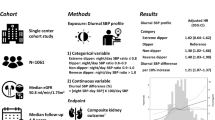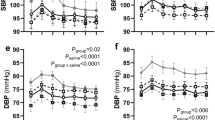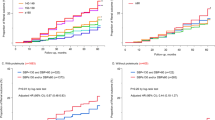Abstract
Salt and water retention, a cardinal feature of nephrotic syndrome, was suggested to be an important factor leading to reduced diurnal blood pressure (BP) variation in renoparenchymal disease. Twenty-four hour BP (SpaceLabs SL 90207), 24-h urine excretion of catecholamines, plasma renin activity and plasma aldosterone concentration were therefore determined in 10 nephrotic patients with normal serum creatinine levels (group A, serum creatinine 1.0 ± 0.2 mg/dl), in 10 nephrotic patients with increased serum creatinine levels (group B, serum creatinine 2.4 ± 0.9 mg/dl) and in 20 controls matched in respect of age and BP. To study the direct influence of fluid volume overload, diurnal BP variation was determined before and after volume depletion by ultrafiltration in 10 patients with end-stage renal failure. Diurnal BP variation was characterised by the difference of mean BP during daytime (10 pm to 8 am) and night-time (8 am to 10 pm). In group A, the systolic and diastolic day–night difference was not changed when compared with the controls (NS). In contrast, in group B the day–night difference was significantly lower than in the controls (P < 0.01). twenty-four hour urine catecholamine excretion and plasma aldosterone were comparable between the study groups. plasma renin activity, however, was significantly increased in group a (P < 0.05). nocturnal bp drop was not related to plasma renin activity in the nephrotic patients. the blunted diurnal blood pressure variation in end-stage renal failure was not influenced by ultrafiltration. the study demonstrates that the blunted diurnal bp variation in kidney disease is unaffected by marked changes in total exchangeable sodium and fluid volume, but is sensitive to changes in glomerular filtration rate.
This is a preview of subscription content, access via your institution
Access options
Subscribe to this journal
Receive 12 digital issues and online access to articles
$119.00 per year
only $9.92 per issue
Buy this article
- Purchase on SpringerLink
- Instant access to full article PDF
Prices may be subject to local taxes which are calculated during checkout
Similar content being viewed by others
Author information
Authors and Affiliations
Rights and permissions
About this article
Cite this article
Barenbrock, M., Spieker, C., Hausberg, M. et al. Studies on diurnal blood pressure variation in kidney diseases associated with excessive salt and water retention. J Hum Hypertens 13, 269–273 (1999). https://doi.org/10.1038/sj.jhh.1000801
Received:
Revised:
Accepted:
Published:
Issue date:
DOI: https://doi.org/10.1038/sj.jhh.1000801
Keywords
This article is cited by
-
High frequency of nocturnal hypertension in lupus nephritis: should ABPM be implemented in usual practice?
Clinical Rheumatology (2020)
-
Effects of dipping and psychological traits on morning surge in blood pressure in healthy people
Journal of Human Hypertension (2012)
-
Loss of nocturnal decline of blood pressure in non-diabetic patients with nephrotic syndrome in the early and middle stages of chronic kidney disease
Hypertension Research (2009)



